
The Engineering Marvel: Touch Button Spring Plate
Touch buttons have become ubiquitous in our daily lives, seamlessly integrating into the interfaces of electronic devices. While users may take their responsive nature for granted, the true marvel lies in the intricate mechanisms that make these touch buttons function seamlessly. One key component driving this efficiency is the touch button spring plate, a small yet crucial element that plays a pivotal role in user experience.
Understanding the Touch Button Mechanism
Capacitive Touch Technology
At the heart of touch button technology lies the principle of capacitive touch. Unlike traditional buttons that rely on physical contact, capacitive touch buttons respond to the electrical charge in the user's touch. This method not only enhances responsiveness but also paves the way for the integration of sophisticated touch button spring plates.
Role of Spring Plates
The touch button spring plate acts as the tactile interface between the user and the capacitive touch sensor. When a user presses the touch button, the spring plate undergoes controlled deformation, creating a physical response that mimics the sensation of pressing a traditional button. This subtle yet effective feedback is a testament to the precision required in touch button engineering.
Material Science Behind Spring Plates
Material Selection
The choice of materials for touch button spring plates is a critical aspect of their design. Common materials include stainless steel, phosphor bronze, and specialized alloys. Each material brings its unique properties to the table, influencing factors such as durability, conductivity, and flexibility. Engineers must carefully weigh these characteristics to ensure optimal performance.
Impact on Durability and Sensitivity
The material composition directly affects the longevity and sensitivity of touch button spring plates. A well-designed spring plate strikes a delicate balance, offering the durability to withstand millions of presses while maintaining the sensitivity required for a responsive user experience. The synergy between material science and engineering precision is evident in this delicate equilibrium.
Engineering Precision: Designing Touch Button Spring Plates
Precise Dimensions
The dimensions of touch button spring plates are meticulously calculated to ensure consistent performance. Engineers focus on factors such as thickness, length, and width to achieve the desired tactile response. The precision in these dimensions is a testament to the level of detail required in the manufacturing process.
Simulations for Optimization
Modern engineering leverages simulations to refine touch button spring plate designs. Finite Element Analysis (FEA) and Computer-Aided Design (CAD) simulations allow engineers to predict and optimize the mechanical behavior of spring plates. This iterative process fine-tunes the design, resulting in touch buttons that meet the highest standards of performance.
Applications and Innovations
Diverse Industries
The application of touch button spring plates extends across various industries, from consumer electronics to automotive interfaces. Their versatility makes them an integral part of devices like smartphones, car dashboards, and industrial control panels. The seamless integration of touch buttons enhances user interaction in diverse environments.
Emerging Trends
As technology evolves, so do the innovations in touch button design. Emerging trends include the integration of haptic feedback to simulate a more tactile experience and the development of customizable touch button layouts for enhanced user personalization. These advancements reflect the continuous pursuit of improving user interfaces in the ever-evolving landscape of technology.
Conclusion
The touch button spring plate may seem like a small component in the vast world of electronic devices, but its impact on user experience is profound. Through a delicate dance of material science and engineering precision, touch button spring plates contribute to the seamless interaction between humans and technology, unlocking a realm of possibilities in the digital age.







